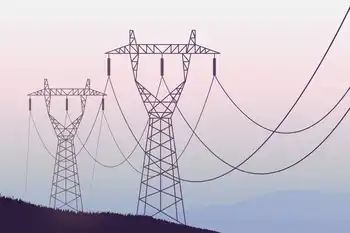Run-of-river facilities provide about 10% of B.C.Â’s power
By Vancouver Sun
Arc Flash Training - CSA Z462 Electrical Safety
Our customized live online or in‑person group training can be delivered to your staff at your location.

- Live Online
- 6 hours Instructor-led
- Group Training Available
At present, the Ashlu is as wild and untamed a creek as you could find anywhere in the world, but soon it will become a working stream in British Columbia's vast industrial forest.
Down at the base of the ridge where Boychuk stands is a broad gravel plain, the bed of the Ashlu, where a backhoe is packing huge broken chunks of granite in preparation to divert the creek's course as part of a new power project about a half hour's drive northwest of Squamish.
It is a scene that has already been played out on 32 small streams around B.C., where so-called run-of-river hydroelectric facilities built by private developers are currently contributing about 10 to 15 per cent of the electricity that flows each year through BC Hydro's provincial grid.
A further 46 independent projects are in development.
Billions of dollars, typically sourced from public sector pension funds and insurance companies looking for slow, steady rates of return, have already been invested - $135 million for the Ashlu project alone.
Over the last decade, the B.C. environment ministry has received 562 applications for water licences, including 97 new applications since January 2008.
An application is no guarantee of a project. Since 2001 the ministry has issued 70 licences for power generation, including 12 replacement licenses for existing BC Hydro facilities.
This summer, Hydro issued a call for new supplies of green power and 25 companies responded with proposals for 168 projects - mostly run-of-river enterprises like Ashlu.
The Independent Power Producers association of B.C notes that the offers represent about five times the amount of electricity Hydro is looking for.
"There is only one buyer, and that buyer only swings by every three years," IPPBC president Steve Davis noted.
Of course, not all of the projects will succeed.
"A hundred staked hydroelectric sites will quickly narrow down to five sites or less that can be developed to economically produce electricity for more than the cost to build them," said Boychuk, construction project manager for Vancouver-based Ledcor Power Inc.
The Ashlu is one of the successful ones.
By the time the project is complete, the Ashlu will be responsible for the generation of enough electricity at peak times to light 23,000 homes.
Come back to the ridge a year from now and you will see the stream broadening into a modest pond at this location, resting against a rubber-and-concrete barrier that will trap a portion of the Ashlu's flow and divert it into a man-made tunnel.
This barrier - you can't really call it a dam - would fit onto a football field, twice over.
The remainder of the Ashlu's flow will continue on its natural path, plunging steeply downhill through a perilous Class Five whitewater route known to extreme kayakers as Commitment Canyon - once you are in it, there's no way out except down.
The surface and tunnel portions of the stream rejoin about 4.5 kilometres downstream, where a small, 49-megawatt hydroelectric generating station is, like the diversion upstream, still under construction.
At both locations, excavators and gravel trucks clang and rumble, dust flies, and there are still-raw scars on the stream banks that were cleared to make room for the hydro facilities.
To Boychuk, the primary allure of a creek like the Ashlu is the rapid descent of its stream course - impassable for migrating salmon, but ideal for the production of electricity.
"Beauty is in the eye of the beholder," he avers.
"A nice, flat, meandering stream is a fish-bearing stream, and that's the last place you'd want to build a hydroelectric project."
Ledcor is working with Quebec-based Innergex on 18 potential small-hydro projects in B.C.
The partners are also building a much smaller run-of-river project on Fitzgerald Creek in Whistler, where the ski resort operator lauds the local enterprise as a sterling model of sustainable development.
Ledcor and Innergex haven't been so lucky at Ashlu, where the Squamish Regional District council expressed such strong opposition that it eventually forced the provincial government to revoke the authority of local governments to regulate independent power projects, or IPPs.
Whitewater kayakers were opposed as well, on the premise that water diverted into the hydro project's tunnel would rob them of the flow volume they deem necessary to travel down the stream.
However, an agreement was struck that obliges the plant operators to relinquish some of their water volume on weekends in spring and fall in order to accommodate the paddlers. There's no issue with stream flow during summer peak.
Ledcor and Innergex also struck a deal with Fisheries and Oceans Canada to compensate for their impact on the stream, by creating 5,000 square metres of new fish habitat in backwaters off the lower Ashlu.
The companies unilaterally bumped their habitat quota to 60,000 square metres.
They were told to carve out tiny brooks and ponds, and fill them with woody debris as refuge for baby salmon, effectively enhancing an old project undertaken by fisheries a decade earlier, and upgrading some existing intermittent backwaters.
"We placed the stumps and root wads from the various work areas in here for the fish. A few years ago I would have said it was just a mess, a bunch of junk, but now I understand that it's actually a good thing," Boychuk said.
Most of that work was completed in August 2007. A month later, the project's full-time biologist Tom Cleugh counted 40 adult coho salmon in there, and this spring, an estimated 14,000 coho fry had taken up residence.
"It's in our business model," said Richard Blanchet, western region vice-president of hydroelectric energy for Innergex.
"We do the extra mile so that the project will contribute to the community. These projects are there for 40, 60, 80 years, so you need to have good communication with the community."
Most public attention on the project, meanwhile, has been negative.
This spring the Western Canada Wilderness Committee produced a video highlighting the construction impacts on the stream-scape at Ashlu, and representing the emergence of independent power projects across the province as "the biggest heist of public resources in Canadian history and an enormous threat to the future of British Columbia's environment, economy and society."
Melissa Davis, executive director of Citizens for Public Power, said run-of-river power is "not quite as green as it appears on the surface."
"True, the power that is generated is greenhouse gas-neutral, but the developments themselves cause significant adverse environmental impacts... all of which have significant impacts on area wildlife, fish, and other aquatic species."
The government's decision five years ago to order BC Hydro to shift low-volume power projects to the private sector came "because the provincial government wants to create opportunity for business," Davis said.
"That kind of decision is more difficult to rationalize when you've got an incredibly profitable Crown corporation that provides fair rates to consumers and significant revenues to the public purse."
Proponents counter that a primary reason for Hydro's profits is its insulation from the financial risks associated with developing small projects.
"In many cases it's two years of fisheries work just to understand whether or not you an undertake a project," said David Andrews, an engineer with Cloudworks Energy.
"We will probably look at 20 possibilities for every application we put in. We've been around for a little while, and we have been involved in the development of two projects that have been constructed, and we are now working on a third that involves six facilities. But that's it.
"If you wanted to go out right now in the midst of the credit crisis and built a project, it's going to cost a lot more. If you are a taxpayer, that's the beauty of having these private-sector guys out there. That's not BC Hydro's risk, it's the private guys'."
One of the highest-profile operators has been Donald McInnes, a lapsed mineral exploration promoter who has used his considerable entrepreneurial skills to assemble one of the richest project rosters in the sector.
His company, Plutonic Power, has already spent $200 million, and arranged financing for a further $460 million, for a cluster of run-of-river projects at Toba Inlet on the B.C. coast north of Powell River.
The company's financial model is straightforward - go to the stock market to raise venture capital for the initial, multi-million-dollar exploratory stages of a project and if your engineers, hydrologists and biologists determine it's viable, talk to pension funds and insurance companies about financing the actual construction.
"I'm typically investing our company's money [through equity offerings] when the risk is highest and we have no certainty of outcome," McInnes said.
"Once the projects are construction-ready and all of that development risk is gone, then other companies typically come in to make an investment - but they're looking for less of a return."
In all cases, the company first looks for streams that have a waterfall - a natural barrier to migratory salmon.
But even then, there are risks.
"We were working on one stream near Gibsons called Rainy River. The natural barrier for fish wasn't a waterfall, but it was a fish ladder that the pulp mill told us had never worked.
"In our first two years of studying this stream there were no fish. In the third year there were two fish above the ladder and in the fourth year there were six.
"So all of a sudden the economics of the project changed. We were going to have to move our powerhouse upstream, which meant a loss of revenue.
"I still think Rainy River is a good project, but it's not of interest to us any more."















